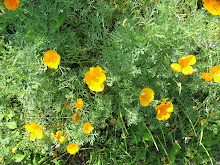The past year may go down in history as one of the worst years in gardening, at least in the past decade. Above-average rainfall and below-average temperatures during the crucial months of the growing season resulted in a below-average yield, especially with tomatoes. In November, I abandoned my experiment of determining how much I benefited monetarily from planting and harvesting edibles, reporting a negative balance. And on some days, I spent more time clearing out infected fruits and vegetables than harvesting healthy ones.
 The Minton Stable Garden in bloom, August
The Minton Stable Garden in bloom, AugustHowever, I still find gardening to be a satisfying act, providing physical and emotional benefits to those who participate in it. Another year at the Minton Stable Community Garden led to more friendships with gardeners and other Steering Committee members. A community of bloggers provided advice and ideas for improving my garden practices as well. And the rain had some advantages, including a lower water bill for the community garden (only $141.82, down from last year's $203.40). As long as I have my 140 square feet in JP and land at home, and Massachusetts hasn't yet disappeared under rising sea levels, I'll continue gardening. Here is my second annual set of lists, with items not in any particular order.
Top 5 successful plants:
1. Kentucky Wonder pole beans
2. Fiesta organic broccoli
3. Forellenschluss Romaine lettuce (grown in Minton Stable Garden)
4. June-bearing strawberries (before the botrytis set in)
5. Volunteer raspberries--they liked the fall conditions
Top 5 failures:
1. All tomato varieties (except volunteer cherry tomatoes)--due to below-average temps and late blight
2. Anything I tried to grow in my backyard--too shady
3. Spinach after the invasion of leaf miners
4. Irises I tried to transplant to a sunnier location in front yard--maybe they'll bloom next year
5. Zinnias--planted late and not given enough room
Resolutions for 2010:
1. Continue growing the same volume of tomatoes, trying some different varieties, but make a point of pruning them to strengthen plants and ensure that they get more light.
2. Grow more varieties of broccoli, like Piricicaba and broccoli raab, and other plants, including kale and other greens, coriander, parsley, and other herbs, carrots, and cauliflower.
3. Reduce the size of the strawberry bed to make room for the raspberries.
4. Keep trying to achieve that fall crop of greens, perhaps by planting better varieties sooner, starting some indoors in August so they can grow out back under row covers, or by some other means.
5. Be more aggressive in thinning out perennials, to avoid diseases like powdery mildew or to keep them from taking over my MSG plot. Black-eyed susans, anyone?
6. Take better photos, including sharper close-ups and documentation of the garden over time.
Happy New Year! I'd be curious to read the resolutions of other gardeners.





















































